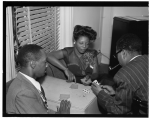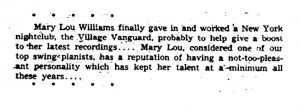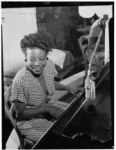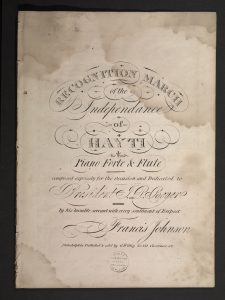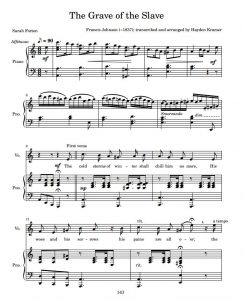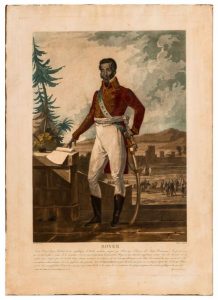My first encounter with the composer Mary Lou Williams was upon stumbling across her choral composition “Black Christ of the Andes (St. Martin De Porres).” The dynamic range and gratifying dissonance in the harmonic texture of the piece gave me an almost ethereal and cathartic feeling, and I immediately fell in love.
Born in Atlanta, Georgia in 1910, Williams almost immediately entered the jazz scene; at age 15, she was already playing alongside Duke Ellington and catching the musical attention of Louis Armstrong1. She promptly started playing the piano for different regional bands in Pittsburgh and embarking on tours with a chaperone, but she soon was navigating the music scene on her own as a young woman. Critics soon began complimenting her talents, giving her honorific nicknames such as “First Lady of the Piano” and the “lively Queen of the Ivories.”2
As a budding musician and composer, her specific positionality as a Black woman played a crucial part in her reception by critics and her audiences. Black composers, artists, writers, and performers of the time were already being pushed to be perceived in the leadership class of the “talented tenth,” wherein there was unjust pressure to “[elevate] the music of their race”.3 In regards to women, work within the entertainment industry was not seen as suitable for them, where “no self-respecting woman would pursue such interests, especially outside the realm of classical music.”4 Williams’ ability to infiltrate the male-dominated, instrumental jazz scene of the time was certainly unique in this respect. She dutifully worked to portray herself as a “serious” jazz musician by not interacting with the audience or smiling during performances—likely to set herself apart from the female musicians of her time and avoid demeaning stigmas from being placed on her as well. The self-assuredness and resoluteness Williams demonstrated throughout her early and later career could be an additional factor, as she was often not afraid to protest injustices that she or her band members faced.
Williams’ existence as a woman within the jazz community put a further pressure to be perfect, enacting a sort of double-bind. Her demonstrated assertiveness may have helped with her acceptance early on, but unfortunately did not allow her to escape from misogynist rhetoric. In the late 1940s, there was a sudden change in her critical reception, where she was described as having an egregious attitude that hindered her success as a musician and composer.5,6
This seems to stem from the idea that women must always be pleasant, agreeable, and easy to digest—especially when one is a public figure, and even more so as a Black woman. It did not help that Williams had been recently dealt with hardships—she went through a divorce in 1940, and in 1942, she remarried to a man who was later believed to be physically abusive.
Decades later, the public was once again praising her and further illustrating her significance in jazz and American music. Newspapers were dubbing her with even mightier nicknames of “the First Lady of Jazz” and “The Queen of Jazz.”7 Williams passed soon after in 1981, and critics continued to immortalize her prowess and influence on the genre. She was certainly well-recognized for her talents, even alongside the shift towards negative judgements on her character, but does that absolve and erase the obstacles she faced during that time? Throughout the entirety of her lifetime, Williams still managed to overcome countless disadvantages as a Black woman, as a woman in jazz, and as a Black woman in jazz.

